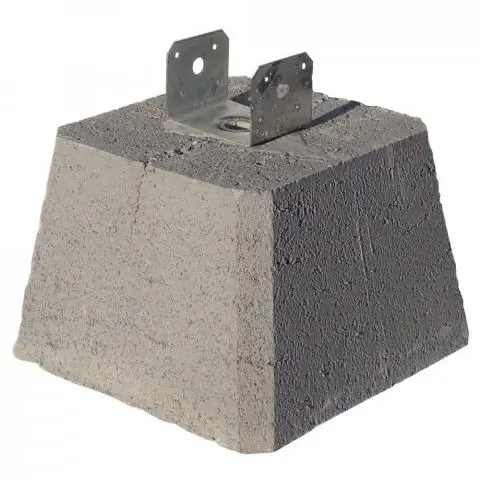
Table of contents:
- Author Bailey Albertson [email protected].
- Public 2023-12-17 12:53.
- Last modified 2025-01-23 12:41.
The foundation for a bath with your own hands

The bath foundation is essential for the durability and safety of the building. Therefore, the base requires proper construction, and the design options are varied.
Content
-
1 Types of foundations
-
1.1 Pros and cons
1.1.1 Table: main features, pros and cons of each type of foundation
-
-
2 Preparation for installation
- 2.1 Calculation of materials
- 2.2 Tools
-
3 We build the foundation for the bath with our own hands
3.1 Video: do-it-yourself simple columnar foundation
Types of foundations
The base is an important element of any structure, as it ensures the reliability and quality of the walls. The bathhouse is no exception. Therefore, before construction, you need to choose the type of foundation, which is presented in several forms.

The foundation is the basis for the reliability and durability of the building
-
The strip foundation is distinguished by a simple construction technology. It can be monolithic or prefabricated, but any option is suitable for baths made of bricks, frame elements or timber. For the construction of the base, cement mortars are used, which include rubble, crushed stone, sand, gravel. Reinforced concrete blocks can also be used for strip foundations.

Strip foundation The tape base is easy to construct
-
Screw piles are convenient and practical. The design assumes the presence of screw supports with a drill on the lower end. The piles are made of reinforced concrete and mounted using a copra. In this case, the grillage can be different: wooden, metal, tape, reinforced concrete. The choice depends on the height and area of the structure, type of soil, climatic conditions. The type of foundation is optimal for baths, the size of which is 6x6 m or more.

Foundation on screw piles The helical design is well suited for unstable soils
-
The foam block foundation is easy to install. The material is aerated concrete, which can have various characteristics. For the base, the most durable elements resistant to moisture and mechanical stress are used. It is easy to create a strip or columnar foundation for a bath from foam blocks, the size of which does not exceed 3x4 or 6x4 m.

Laying foam blocks Installation of foam blocks is distinguished by a simple technology
-
The columnar version involves deepening several pillars in a row, which are connected by reinforced concrete round beams. The foundation is optimal for a log bath, one-story buildings. During installation, pillars are used, reinforced with round pipes, which is necessary to avoid rupture during ground movement. The side walls of the holes for the posts are lined with roofing felt to increase the reliability of the structure.

Diagram of a columnar foundation The construction of a columnar foundation does not require complex actions
Pros and cons
Each type of foundation has certain properties and can be built using different methods. When choosing options, you should know the positive and negative points, which will create a reliable basis for the bath.
Table: main features, pros and cons of each type of foundation
| Foundation type | pros | Minuses |
| Tape |
Reliability, no need for rework due to architectural changes, even load distribution |
High cost of construction for a bath |
| Screw piles |
Fast erection, good load-bearing capacity, installation in any season, no need for soil preparation, environmental friendliness, the possibility of building expansion |
Deformation in case of violation of the installation technology, only high-quality screw piles are needed, insulation of the lower part of the structure is needed |
| Foam blocks |
Simple installation, application on various types of soil, durability and reliability |
Only high-quality foam blocks with high characteristics are needed, the impossibility of creating very extensive structures |
| Columnar | Suitable for a small bath, does not require large costs, easy installation, durability and strength | Used only for lightweight structures, careful adherence to installation technology is required |
The choice of the type of foundation depends on factors such as the quality of the soil, the size and material for the bath, the planning of subsequent expansion, the location of the building.
Preparing for installation
Among the variety of options for bases for a bath, the columnar type is distinguished by a simpler technology. The foundation is a good basis for a bath no more than 6x6 m in size. Too extensive structures are expensive. Therefore, the columnar base is in demand in the construction of private baths, even of a large size.

The bath plan is drawn up before construction
Preparation includes creating a plan, determining the size of the bath. The site for the construction should be fairly flat, if necessary, the site is processed. And you also need to determine the material from which the bath will be built. Columnar foundations are optimal for timber structures, and therefore wood is often the basis for walls.
Calculation of materials
The peculiarity of the columnar foundation is that each column is located in places of special load, for example, in the intersection of walls or at the corners of a building. Therefore, the layout of the bath is preliminarily drawn up, on which key points are indicated. The distance between such zones can be from 1.5 to 2.2 m. The pillars are connected with grillages, and if the distance between the points is more than 2.5 m, then they use randbeams. According to these features, the number of pillars is calculated, and the size of the bath, the shape of the structure is also taken into account. Special online calculators make calculations much easier. This is due to the fact that time-consuming calculation requires professional knowledge.

A simple diagram is easy to draw up yourself
The amount of materials also depends on the type of soil. For example, on a clay base, it is best to create a buried foundation, and sandy ones serve as a good foundation for a shallow foundation. For the concrete mixture, cement, sand are used, and fine crushed stone is also needed. For work, metal rods are required, which serve as reinforcement of the pillars. Roofing material and asbestos pipes are selected depending on the number of supports. The diameter of the asbestos elements must be at least 250 mm. Reinforcement rods are easy to count, since for a column with a diameter of 200 mm, 3 elements with a section of 10 mm are used. With a larger pipe diameter, the number of fittings must be increased.
Tools
For work, you will need a container and a device for mixing concrete. The depth of placement is at least 1 m, and a hand drill is needed to create wells. You can also create pits with a shovel, but they will not be even enough. A building level, tape measure, twine will be required to determine the evenness and correctness of the location of key points.

The foundation reinforcement must have a diameter of 12 mm
We build the foundation for the bath with our own hands
The columnar base can be made according to various methods, but installation is simpler using asbestos pipes. The complex of works includes the following stages:
-
On the territory, marking is carried out according to the scheme, key points are marked with pegs. With the help of a drill, holes with a diameter of 25 cm are created. The depth of the wells should be at least 50 cm.

Garden drill Drill makes it easy to create wells
-
A metal mesh with small cells is laid on the bottom, a layer of sand concrete 10 cm thick is poured. Several reinforcing rods are mounted in the center of the well, the length of which exceeds the depression by 10-15 cm. The walls are covered with roofing material or other material for waterproofing.

Roofing material The number of rods depends on the diameter of the posts
-
An asbestos-cement pipe with a diameter of 10 cm is installed on the bottom of the recess. The elements should rise about 40 cm above the ground level. 50 cm cement mortar is poured inside the pipes. The support is slightly raised, which will allow the concrete mixture to drain slightly to the bottom and form an expansion. The mixture is poured inside, not reaching 15 cm to the top.

Base for the post Fittings are placed in the center of the pipe
-
After installing the rod inside the pipe, add cement to the top. Brickwork is mounted between the pillars, taking into account the sewage outlets, ventilation holes, which are built-in pipes. The brick base is covered with a layer of cement and roofing felt for waterproofing.

Column foundation for a bath The construction of the bath can be started in 7-10 days, when the concrete has gained sufficient strength
The service life of the foundation for the bath, created using the columnar mounting technology, is more than 70 years. The technique is simple and does not require the use of complex tools and materials.
It is easy to create a foundation for a small bath with your own hands thanks to video recommendations that clearly demonstrate the construction process. In this case, the technology can be adjusted taking into account the individual preferences of the site owner, but the basic rules must always be followed.
Video: do-it-yourself simple columnar foundation
High humidity and air temperature are the features of the bath operation. A strong and durable foundation allows you to avoid unforeseen repairs to the structure, therefore, the right choice of construction technology and high-quality materials are the main requirements for self-construction.
Recommended:
How To Build A Fence Made Of Wood (pallets, Boards And Other Materials) With Your Own Hands - Step By Step Instructions With Photos, Videos And Drawings

Building a wooden fence with your own hands will save you from uninvited guests and create an atmosphere of genuine home comfort on the site
How To Build A Sun Lounger With Your Own Hands From Wood And Other Materials - Step By Step Instructions With Photos, Videos, Drawings, Work Progress And Dimensions

How to make a sun lounger with your own hands for a summer vacation. Selection of materials, types of structures and drawing up a drawing of the selected type with further assembly
How To Make A Font For A Bath With Your Own Hands, Wooden And From Other Materials - Step-by-step Instructions With Photos, Videos, Dimensions And Drawings

Why do you need a hot tub, its design. Types of fonts. How to make a font with your own hands: step by step instructions. Photo and video
How To Build A Barrel Bath With Your Own Hands - Step By Step Instructions With Dimensions And Drawings, Photos And Videos

What is a barrel bath and its varieties. Design advantages and disadvantages. The choice of material for the construction of a bath and step-by-step manufacturing instructions
How To Make A House For A Cat And A Cat With Your Own Hands: Types Of Cat Houses (out Of The Box, Other), Drawings, Sizes, Instructions, Photos Step By Step

Requirements for the cat house. Step-by-step instructions for making a house from different materials. Where is the best place to place a house for a cat
